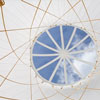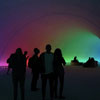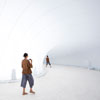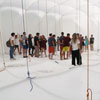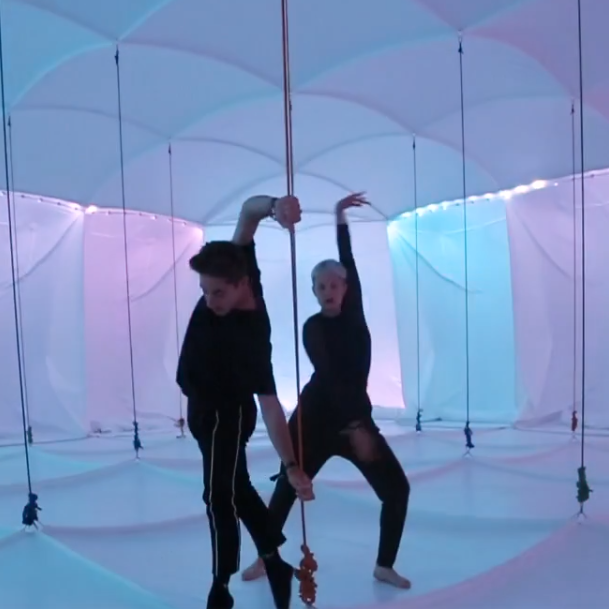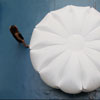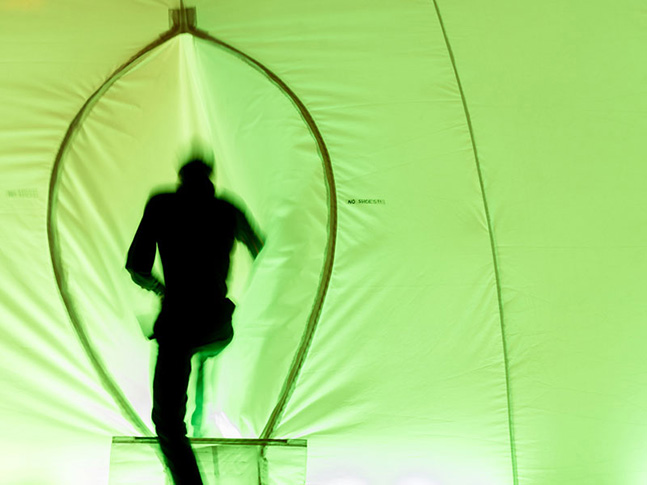
This award-winning design team from Madrid creates inflatable architecture. In their first appearance in the USA they will bring Space Cloud, an innovative 8,000 sq.ft. pavilion with an integrated LED lighting system to Kit Carson Park. It will be the site of multiple art installations and performances and a pre-festival STEAM Day for 300 Taos County students. The designers will improvise custom lighting effects throughout the festival to respond to the changing events and installations.

About the Artist
Espacio La Nube is a design and architectural team including Hugo Cifre, Álvaro Gomis García and Miguel Ángel Maure Blesa based in Madrid, Spain.
Skills Applied
 PRESOSTATIC PNEUMATIC STRUCTURES
PRESOSTATIC PNEUMATIC STRUCTURES
 INFLATABLE ARCHITECTURE
INFLATABLE ARCHITECTURE
 ENGINEERING DESIGN
ENGINEERING DESIGN
Message From The Artist
Inflatable structures and inflatable buildings are used in many ways including membrane roofs and covers, sails, pavilions, furniture and art sculptures. Inflatable habitats or expandable habitats are pressurized structures capable of supporting life in outer space whose internal volume increases after launch. They have frequently been proposed for use in space applications to provide a greater volume of living space for a given mass.
Espacio La Nube’s inflatable pavilion falls within the category of the “Presostatic Pneumatic Structures”. It is a monolayer inflatable pavilion that achieves structural equilibrium by filling the totality of the pavilion volume with a constant flow of air through a system of ventilators that never stop working, which allows it to work at much lower pressures than the pressurized structures. If you want to play around with designing inflatables and see how they work you can try out some of the STEAM Activities in the STEAM Wiki below. You can make inflatable art sculptures using simple materials like plastic bags and tape.
Explore Artist Tool
The Explore Artist Tool provides a step-by-step process for getting to know the artist, to see examples of the artists work, research the science and technology that informed the work, experiment with some hands on activities and tools to better understand how the artist thinks and works, collaborate with your peers to exchange ideas on what you learned and what you liked, and finally to present something that you write or create that is inspired by your research and exploration. This tool will take you through each stage of the process with a focus on each artist’s work.
Explore all artist pages
In the explore phase you go to the Explore Artists to click through each artist page and learn about them all. You can watch their videos, read their bios, and flip through their STEAM wiki for articles, science research and STEAM activities related to the artist’s work. STEAM stands for science, technology, engineering, art and math. Look out for how any of these are used in the artists work. The goal is to learn a little about each artist and start to think about which one inspires you most or which one you would like to learn more. Your class could decide to all work together on one artist, or that everyone choose a different artist.
Research the STEAM
Once you have explored all the artists it is time to pick your favorite and go back to their page. Now you can dig deeper in the STEAM wiki to research the artist. Learn as much as you can about how the artist made the installation. Find out about the technology that was used. What is the science that informed it? How does the artist work impact communities? the environment? Why do you think this work is interesting or important? The goal here is to pick a STEAM activity. Again it could be a group project or individual project.
Time to experiment and create with hands-on activities
Now that you and your class have decided on the artist and STEAM activity it is time to start experimenting. if you are writing a report start your draft, if you are creating an art piece or installation start sketching or constructing prototypes or you may be trying out a new science experiment. This is your chance to do some hands on project to really understand the artist’s art process.
Collaborate with peers to share and get feedback
The next step is to collaborate with your peers to share your work, exchange ideas and get feedback. Perhaps you have been working on an experiment and you need some help. Maybe you are excited about something you learned or created and just would like to share with you peers. This is the time to discuss and listen to other people’s ideas and what they learned to get a different perspective. Check out the Feedback Tool for some suggestions on how to give and receive feedback constructively.
Present your final creation
Once you have received feedback and finalized your project it is time to share. This could be in the form of an art exhibit if everyone chose to create art. Perhaps you all decided to work on the same activity and you all share your experiences working on the project. You will decide this with your teacher and peers. Have fun and don’t forget to share your work with us in the form of photos or videos! We would love to see what you learned and we will be sure to share with the artist.
STEMarts Wiki
The STEAM-wiki is a place to get started with your artist research. You will find links to articles, images, video, and tutorials that relate to Espacio La Nube’s work.
You can search by clicking on the links below or you can click on the topic words in the word cloud for specific areas of interest. For example, INFLATABLE ARCHITECTURE to learn about the engineering principles behind this new kind of inflatable structure or LED Lighting to learn more about creating art with LED lights. If you are looking for STEM + Art activities type in STEAM Activities. To view all options, use the keyword ALL.
Remember the resource is an open forum sharing links and ideas that others have found – always check your sources and give credit where credit is due. The open source movement generously shares its knowledge and relies on user feedback – so if there’s something really good or doesn’t work let others know.
article engineering inflatable architecture inflatable art inflatable sculpture inflatable structures moon habitat pneumatic structures STEAM activities video View All


